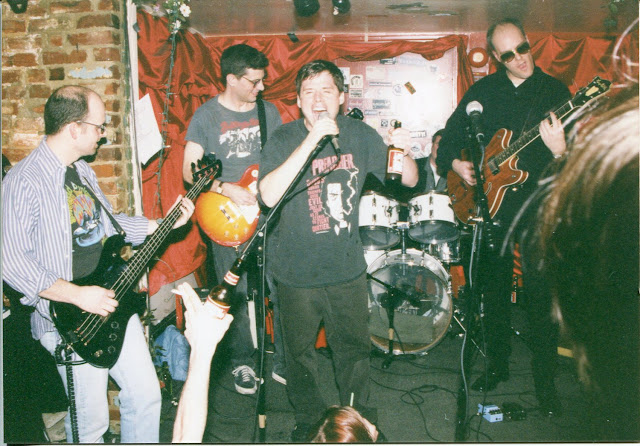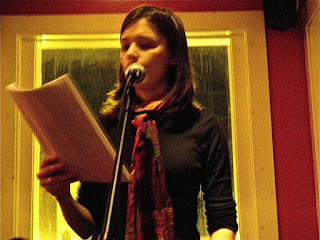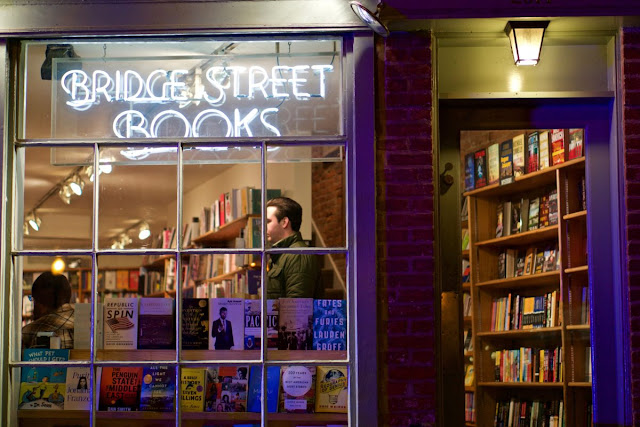Tom Doyle, Leslie Bumstead, Alyse Knorr, and Aaron Winslow in Conversation
The authors will read from their latest work in Washington, DC on 1-26-18 at The Black Squirrel DC, 8:00PM. Join the event on Facebook.
Tom Doyle, Author of War and Craft
 |
From left to right: Tom Zanol (bass), Jay Austin (guitar), Tom Doyle (vocals), Jeff Roberts (drums), Chris Cook (lead guitar).
Photo Credit: Carl Bruch
|
________________
CL: Where was this photo taken? How does it represent your creative life?
Tom: In 1999, I quit my law firm and embarked on the multinational millennial pilgrimage that led me to becoming a writer. The climax of that pilgrimage is the moment captured in this photo on Leap Day 2000 at the Velvet Lounge in Washington, DC. With my friends, I'd formed a Guided by Voices cover band, Voided by Guises, and this is my theatrical version of the GbV song "Hot Freaks."
CL: Respond to the following popular quote about creativity?
Tom: I'm not an Apple user, but as someone who creates secret histories, this quote speaks to me. For my trilogy about magician soldiers and psychic spies, I've been a magpie, gathering whatever shiny baubles I can find from real world history and literature, then weaving them together into a coherent whole. In connection mode, my mindset resembles that of a paranoid schizophrenic: "It all fits together, man, it all fits!" But I understand what Jobs means about the little tug of guilt—I don't feel I'm inventing something from scratch so much as mining the world and my own experience and connecting the best bits.“Creativity is just connecting things. When you ask creative people how they did something, they feel a little guilty because they didn’t really do it, they just saw something. It seemed obvious to them after a while."
—Steve Jobs
Leslie: I love the idea of “connection mode” —for me this is how I revise my work, and it can be arduous and frustrating but when I finally find the connections and the puzzle fits together, it’s the greatest. Your comments actually got me thinking about my current project (from which I’ll be reading) which is still in process—I think it could benefit from some more mining in the history of the cyborg in the world and in literature. As of right now I’m still in “how does all this shit fit together!?” mode.
Tom: Cyborgs are great fun. Here's a nugget for you (though I don't know if it fits): some speculate that Baum was inspired by all the Civil War amputees that he saw as a child to create the Tin Man in the Wizard of Oz. Also fun—just toured the Johns Hopkins Applied Physics Lab, where they've developed the mentally controlled prosthetic arms that can also sense things.
Leslie: Love this! Thank you!
Alyse: Sometimes making connections means first ensuring there are enough “variables,” or, as Benjamin Percy puts it, “flaming chainsaws” in the piece so that they can connect and collide with each other. Every time one of my own pieces feels boring, it’s because there aren’t enough variables. For instance, in the first draft of my book Copper Mother, which is about an intelligent extraterrestrial species visiting Earth after hearing the Voyager Golden Record, I focused only on the visitors themselves. But when I added in more of a focus on their ambassador, “Jane,” and a plot line involving Jane’s grief for a deceased beloved and a little bit of time-traveling, everything felt richer. I even find that once I add the variables in, they find ways to “connect” themselves!
CL: The ancient Greek terms zoe and bios both mean life, but they are not interchangeable—scholar Carl Kerenyi wrote in Dionysos that “Zoe is like seeing Earth from space... Bios involves swooping down from space, closing in on the scene, seeing the details...” How would you apply zoe and bios to the creative life?
Tom: Despite the golden age's notoriously underwritten characters, etc., I think only a few well-known science fiction writers have attempted a pure zoe novel—Olaf Stapledon comes immediately to mind. Virginia Woolf was a fan of his sweeping zoe style, perhaps because it was almost the exact opposite of what was then her approach to time and life. I expect Stapledon felt similarly about her work, and I think that's all very cool.
In science fiction and fantasy, the best work is usually a dynamic between zoe and bios. Zoe, because unlike much of literary fiction there often has to be an element of explicit worldbuilding in speculative fiction, and that endeavor is zoe. Bios because if you want readers to engage with the big ideas of your worlds, they'll usually need specific and compelling narrative action with interesting fleshed-out characters.
In my own trilogy, zoe is the panoramic secret history, surveying many generations and their ghosts. But the conclusion of the trilogy indicates that the work is indeed bios—the characters are more legendary than mythic, and their lives (like a legendary cycle) have beginnings, middles, and ends.
 |
| Photo Credit: Beth Delaney |
In Tom Doyle’s American Craftsmen trilogy (Tor Books), magician soldiers fight their way through the legacies of Poe and Hawthorne as they attempt to destroy undying evils—and not kill each other first. Tom writes in a spooky DC turret. You can find free text and audio of his award-winning short fiction at www.tomdoyleauthor.com.
Leslie Bumstead, Author of Cipher/Civilian
 |
| Photo Credit: Douglas Farah |
CL: Where was this photo taken? How does it represent your creative life?
Leslie: This picture was taken at my desk in my house. I’ve had this desk for most of my adult life, I realize as I’m writing this. I left it behind when I lived outside of the US, but other than those years, it has been my writing place.
I show up here every day at about 5:30 am. It’s quiet and dark and my favorite time of day. I can write and read and drink coffee and pretend there’s nothing else in the world to be done. These early hours are when I generate most of my poems; I can work on them at other times of day, but the initial creation usually happens before dawn.
CL: Respond to the following popular quote on creativity?
Leslie: The writing experiments I love most, and what I do in my own writing practice, are predicated on this idea. The poem almost always begins with writing without knowing where I'm going or what I'm talking about. I don’t think when I write, I just write. Words suggest other words. I adore this activity. I’ve done this for so long that sometimes when I have to write something intentionally for an audience (proposal, class description, bio, article, etc.), I find it wildly taxing. I don't like having to use words to express the thought I know I have. I want words to create the thought I didn't know I had, or haven’t even had yet—the articulation creating the awareness/thinking.“Don’t think. Thinking is the enemy of creativity. It’s self-conscious, and anything self-conscious is lousy. You can’t try to do things. You simply must do things."
—Ray Bradbury
Tom: Yeah, the flip of that is sometimes the trouble is figuring out where the cool thing I've written should go, and shoehorning other writing around it to make it work (even if that just means making it shine in its proper light). Because of what you've described, I'm not a plotter, I'm a pantser with trajectory. Being a complete plotter/outliner would be too much like proposal writing for me.
Alyse: I love what y’all have said here. I completely agree, Leslie, though I’ve never articulated it before, how taxing it can often feel to write a communicative document for a set purpose and audience. I, too, am more interested in how E.M. Forster puts it: “How do I know what I think until I see what I say?” I agree, too, that half of writing is getting out of one’s way, stopping the “thinking” process with prompts that let you come in at that “slanted” angle that will yield a creative outcome. This often blows my writing students’ minds—the idea that you shouldn’t have a big idea before you start, and that writing is often about “tricking” your brain into a creative space.
Leslie: Yes! especially the last part about blowing your students minds about tricking your brain. This is my mantra to writing students. It’s particularly interesting in my prison class because the students, many of whom didn’t finish high school and were never in an artistic environment, have never encountered this concept before. The idea that writing is an exploration, and that words can lead you to new places in real time, is a tough sell. I’m constantly trying to think of ways to get them to trick their brains. (I’m not trying to imply anything here about education being related to creativity—as I think conventional education is its enemy).
 |
| Photo Credit: Gillian Farah-Bumstead |
Leslie Bumstead is the author of Cipher/Civilian (Edge) and Hereafter. Her work has appeared in Not for Mothers Only, Boog City, Hotel Amerika, Open Letters, and elsewhere. She co-founded So To Speak in 1993 and co-edited the one-volume wonder, Crow, with Rod Smith. She teaches writing workshops and manages programming at RhizomeDC, a nonprofit community art space in Takoma DC: www.rhizomedc.org.
Alyse Knorr, Author of Copper Mother
CL: Where was this photo taken?
Alyse: In my apartment in Anchorage, AK, a few years ago.
CL: How does it represent your creative life?
Alyse: I usually write on my laptop on the couch, and my cat Promise usually joins me to help out. Creativity to me is about making “butt in chair” time when I can actually sit down and do the work. Creativity only happens when I make the space for it. (Cats are very good at forcing butt in chair time by literally pinning you down).
CL: Respond to the following popular quote on creativity?
“Creativity is a wild mind and a disciplined eye.” —Dorothy Parker
Leslie: Alyse, I so relate to this. And it reminds me that I often tell my students (and myself) that all writing is creative writing because you can write a beautiful sentence in any context. (Though I do think the general distinction is useful/important.) Students so often skip the “labor of putting beautiful sentences together” because they are focused on the awesome idea and haven’t realized the importance of foregrounding the language itself, and also because it is hard work.
Alyse Knorr is an assistant professor of English at Regis University and editor of Switchback Books. She is the author of the poetry collections Mega-City Redux, Copper Mother, and Annotated Glass, as well as a history of the video game Super Mario Bros. 3. Visit her at www.alyseknorr.com
Aaron Winslow, Author of Jobs of the Great Misery
“If you want creative workers,
give them enough time to play.”
—John Cleese
I mean, check out this John Cleese quote: “If you want creative workers, give them enough time to play.”
Could have been spoken by a ruthless tech CEO as he's bulldozing affordable housing to build a staff arcade or something. And If the time I have to be creative is just so that I'm a better "worker," then maybe I don't wanna.
So what I'm wondering is: how do we separate creativity, the good, liberatory kind (like the kind that Leslie helps prisoners tap into, the kind makes cool shit) from Creativity, Inc., the kind that gets easily recuperated by the market? Not looking for a politics of purity here, but just find it interesting that the idea of creativity is so readily associated with a certain style of corporate capitalism—so maybe that's just the parameters we work within.
Leslie: Yes, Aaron, I wondered about that too, with the Jobs quote. Cuz I do like the quote, but not the association with corporate creativity & its desire to devour the idea of creativity.
I don’t know the answer. I fear that capitalism has got us by the balls in a great many ways, and maybe we can resist by first recognizing that the terms are getting mixed up, misused, abused. Not in the sense of purity, as you say, but in the sense of knowing when something is merely rehearsing the status quo (quite violently, as per your example of bulldozing affordable housing while to build a staff arcade) and when something is in fact an act of liberation, or—since that sounds a bit melodramatic—at least an act that interrogates what we know/think we know and what the hell we are doing.
CL: Where was this photo taken?
Aaron: Oh, just an image from the internet that I use as my desktop background.
CL: Job computer, your computer, all of the above?
Aaron: Oh, my personal MacBook.
CL: How do you feel it represents your creative life?
Aaron: Hah! Well, in a few ways: 1) as a reminder (memento mori, if you will) of the constraints on creative life; namely, working shitty jobs; 2) and also as an ironic daily reminder that any art I produce is of the same material as a box—mass-produced, indebted to the commodity and capital, and done under some sort of duress/antagonism; 3) but it’s also an aspirational & inspirational image! bc in a perfect world I could produce writing/art as quickly and seamlessly as this here box factory produces boxes... to have the presence and calm and steadfastness of a box factory... that’s my utopia.
 |
| Photo Credit: Ryan Collerd |
Aaron Winslow's novel, Jobs of the Great Misery (2016), is available from Skeleton Man Press. His fiction, reviews, and essays have appeared in journals such as Social Text Online, Full Stop, Theme Can, P-QUEUE, Smallwork, and Jacket2. He currently works as an archivist at The New School. Additional information and writing can be found at aaron-winslow.com.
_________________
Aaron Winslow, Alyse Knorr, Leslie Bumstead, and Tom Doyle will read from their work on 26 January 2018 at 8:00PM at The Black Squirrel, Adams Morgan, 2427 18 St NW, Washington, DC, third level lounge. Admission is free.
Science Fiction Reading Party will also feature The Galactic Planning Lab: A Milky Way Makerspace with Meg Ronan, music by The Mole Suit Choir, and Anatomy of Collision, digital poetry by Caroline Crawford.
Join the event on Facebook and find out about other Washington, DC area readings at dcpoetry.com.
Books by the authors can be found at Bridge Street Books, in Georgetown
2814 Pennsylvania Ave NW, Washington, DC
Phone: (202) 965-5200
__
If you enjoyed this conversation, please share this post, share your story in the comments below, ask an author a question.
Thank you—
The Creative Life








Comments